Roadside Emergency Kit Recommendations and Checklist
The best roadside emergency kit for your vehicle depends on your needs. We have a short roadside emergency kit or car kit list, including “must have” items for every vehicle, and a longer, more detailed list .
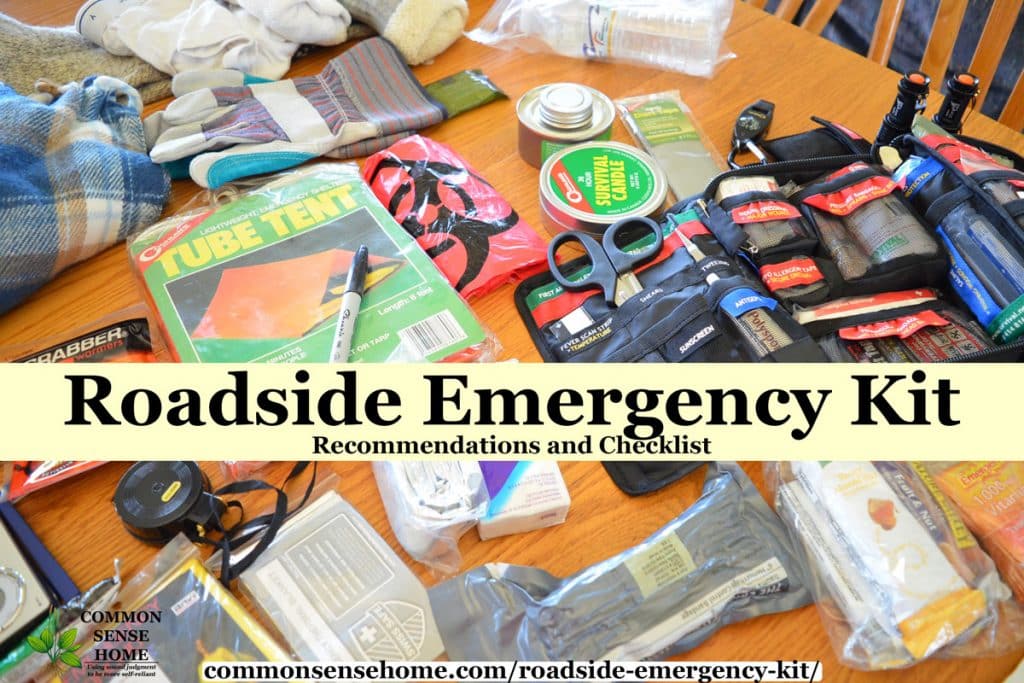
The detailed list includes tools and supplies that are helpful for many types of emergencies. Choose the items that make sense for your vehicle, and keep them organized in a backpack.
Many of us drive nearly every day. Even if you haven't had a breakdown, accident or other roadside emergency yourself, odds are you've seen or at least heard of an accident or disabled car.
Driving long distance whether for work or on vacation adds to your risk. Having a basic roadside emergency kit in your car or truck is important for you and those you may end up helping.
Think about what you might deal with, and if you have the training to handle a situation. Then stock your roadside kit so you have what you need and can use.
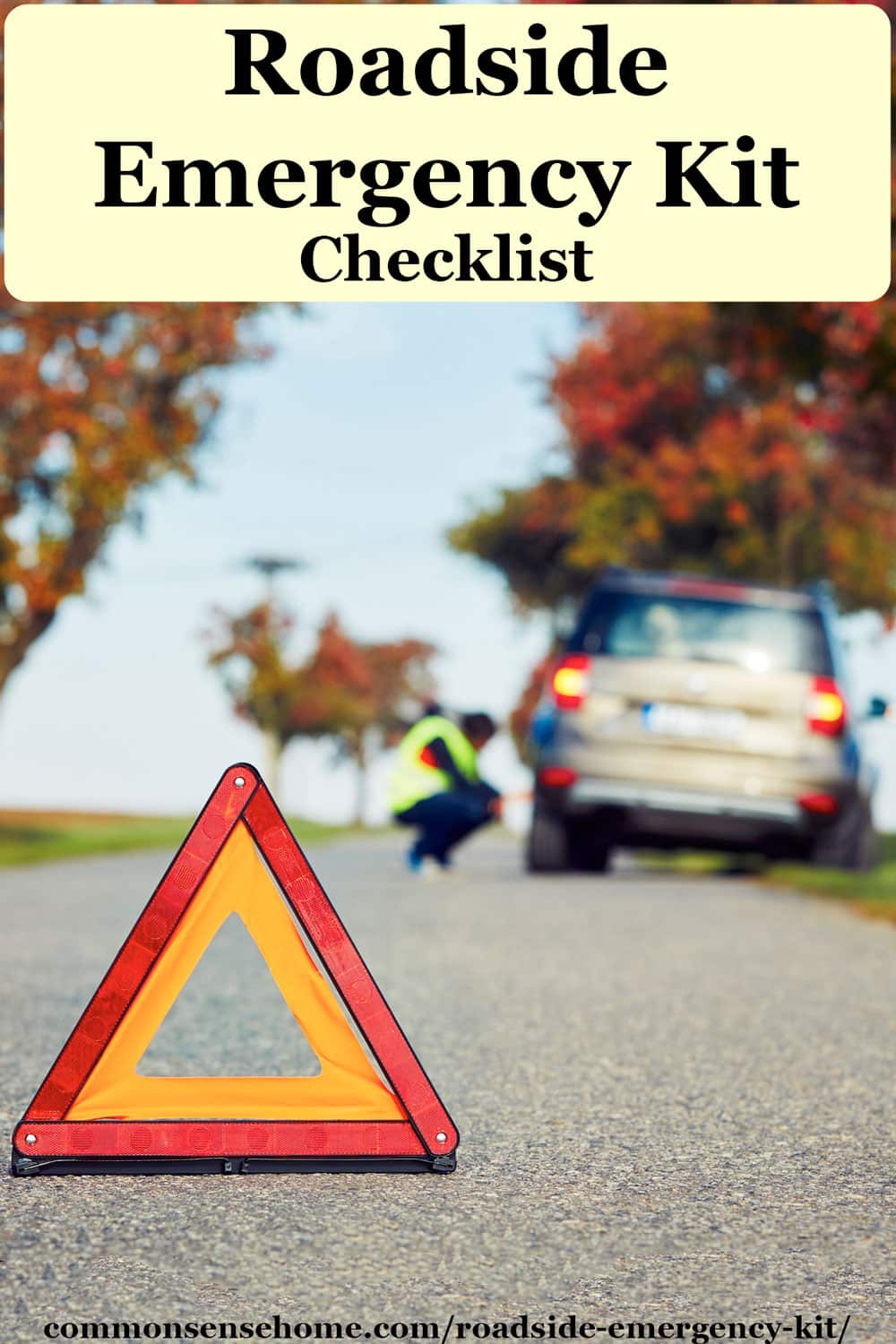
What should be in my Roadside Emergency Kit?
A basic roadside emergency kit should have:
- Rescue knife or other knife in driver's side door
- At least one bright flashlight (review of the Best Cheap Flashlight)
- Tire pressure gauge
- Surviveware Small First Aid Kit or Surviveware Large First Aid Kit NOTE: Both kits are decent but you need to add things to them; see our post for more info Best First Aid Kit Recommendations for Home, Car, Office and Travel)
- Jumper cables
- Heavy duty Work gloves (for changing a tire or dealing with an accident)
- Mini Toilet Paper roll
- Feminine Hygiene products as needed
- Basic tool kit
- Car Fire extinguisher
- Mini Duct Tape
- Sharpie Marker pens
- Cash hidden in the vehicle
- Wool Blanket or at least an emergency blanket
- A few water bottles that have a bit poured out
- Dry food, bars or emergency rations such as SOS Bars
- Reflective Vest or Reflective Jacket
- Personal prescriptions, medications and other items like inhalers or an EpiPen
- A full change of clothes
- A backpack to put all your stuff in (and grab in case you have to walk home)
Over the years we have increased the items we carry around in the trunk of our cars or back of the van. These are our top recommendations.
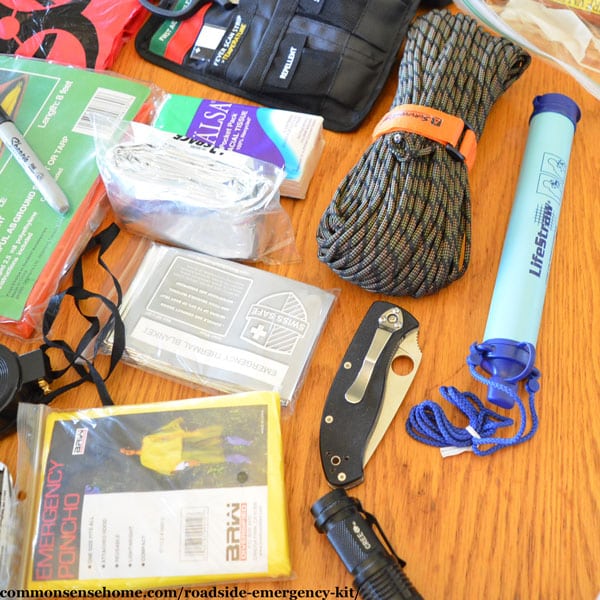
1. Tools
- One or two good knives.
We suggest a rescue knife in the driver's side door, glove compartment, or any other location within reach of the driver. The Buck rescue knife is crazy sharp, and features both a seat belt cutter and window breaker – if it's out of stock or not a good fit for you, we've got some other options listed as well.
- TIP: The headrest on most cars can be pulled off and the metal “spikes” can break the glass of a window.
- Car fire extinguisher
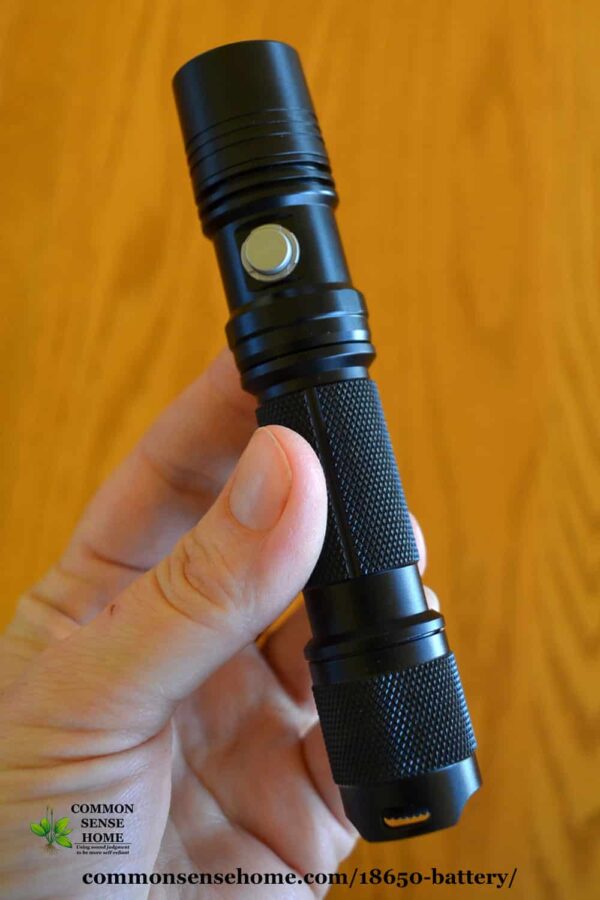
- Flashlights.
We suggest three or more flashlights. I suggest this because I stopped in the dark to help clear an accident. The traffic didn't slow down, even with my flashers on. When I put the flashlight with the strobe light on, facing into traffic, cars slowed down. If I had a second flashlight facing the other way, it would have been safer. I needed the 3rd to see what he was doing in the dark.
A few years later I did come across another accident and used 4 flashlights, 2 for slowing traffic and I shared one with another person as we searched the scene of the accident.
Consider any of these:- A pack of inexpensive Kootek XPE-Q5 LED flashlight. Remember to get extra batteries – either the Panasonic Eneloop Pro or Tenergy AA batteries. (swap rechargeable batteries during daylight savings each year)
- The neutral white ThruNite TC15 v3. These are VERY bright. We like the simplicity and quality. The ThruNite flashlight requires 18650 batteries and you will need an 18650 charger also.
- The tiny Lumintop EDC 01. Very small keychain type flashlight that uses AAA batteries. See the full Lumintop EDC01 review here.
- Nitecore Tip2 is a super bright key-chain sized flashlight and is rechargeable using USB.
- USB Charger. A 12 volt cigarette dual USB car charger and spare cables for each type of cellphone
- Tire pressure gauge
You need to be able to check your tire pressure. We recommend a manual one.
- Paracord and bungee cords to make a makeshift tent, or tie a door or hood closed.
- Pepper spray for personal protection (grab this for you get home bag)
- Basic toolkit or advanced kit, although most cars are complicated enough that we may not be able to fix them, we can use the toolkit to make very minor or temporary repairs. I have had my mirror torn off or damaged by deer or other animals or debris numerous times so far in my life, and duct tape and a tool kit let me repair it temporarily a few of those times.
- If you don't want to carry a full toolkit consider a Leatherman Wave+ multi-tool for quick repair. The multi-tool could be a substitute for a tool kit if you rent vehicles a lot.
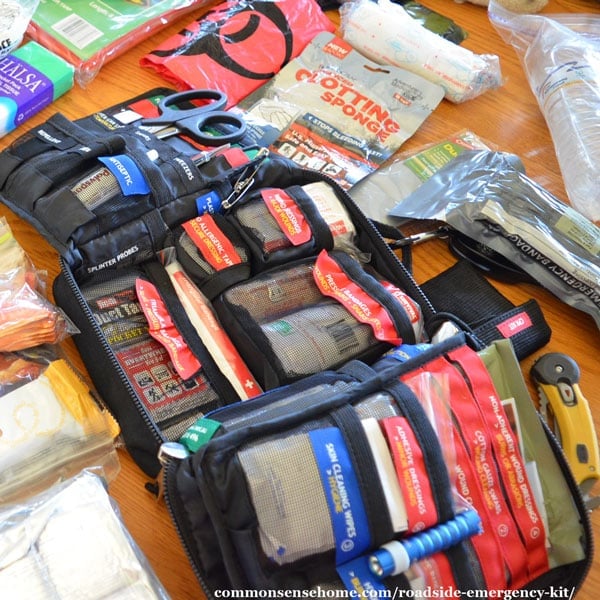
2. First Aid Kit 
Your first aid kit should have everything you need to handle serious injures such as: controlling serious bleeding, managing burns, head injuries. dealing with broken bones and of course handling minor emergencies. The kit should also help with managing shock and even dealing with cardiac arrest.
You might want to have a tiny first aid kit in your get home bag and larger safety kits in the car. Every roadside emergency kit needs a first aid kit to help you and others until help arrives.
You need to know how to perform basic first aid. If you don't know how, get First Aid training online or attend classes for $25 to $200. When you buy a first aid kit, learn how to use everything inside that kit. Note: Even the good kits need additional items added such as a flashlight, tourniquet and QuikClot gauze.
Recommended Smaller First Aid Kits
Recommended Mid Size First Aid Kits
The 12 survivors roll is our favorite medium sized first aid kit, but it requires you to add items. For more information on other smaller, medium and larger First Aid kits see the Best First Aid Kit or Build Your Own Custom First Aid Kit articles.
Don't forget, personal prescriptions, medications and other items like inhalers or an EpiPen and/or feminine supplies as needed. Remember heat can break down medication so be careful what you store in your car in summer heat.
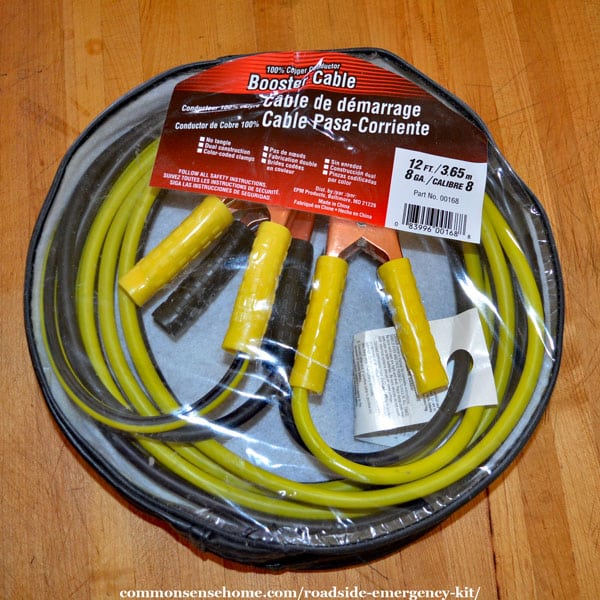
3. Breakdowns and Towing Equipment
- Jumper cables (booster cables)
Heavy gauge means less resistance so more amperage for the jump
- One or preferably two pair of Heavy duty Work gloves
(make sure you pick your correct sizes)
- Tire Iron and a heavy duty scissor car jack
Note: some cars come with a single arm tire iron.
- Heavy Tow Strap if you have ever towed someone, a strap is a LOT safer than just rope or chain.
- Fuse kit various types
- Safety Reflective Safety Vest or Reflective Jacket
(reflective so you are protected working in the dark)
- Sheet of heavy cardboard or large kneeling pad (to work under the vehicle if required)
- Quick flat recovery Fix a Flat (or similar)
- Road Flares
- Electronic Road Flares these avoid the risk of fire but require 6 AAA batteries (Lithium or Rechargeable) and you might also want Road warning flags or a reflective triangle because they don't need batteries.
- Get a REAL spare tire, if possible, and make sure it has correct pressure
- Print out or hand write a paper phone and contact cheat sheet in case your cellphone dies or is damaged
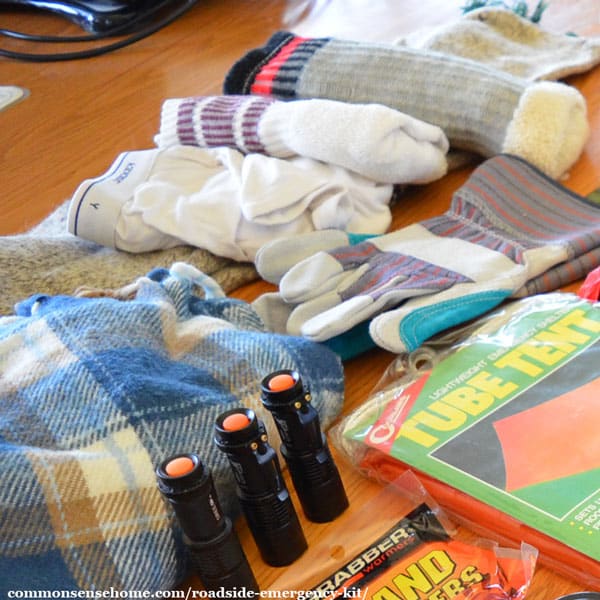
4. Personal Hygiene & Comfort Items
Personal Hygiene Items
Toilet Paper. You can use individually wrapped singles or just put a couple rolls in ziplock bags.
A family friend was in World War II and he said “the 1st time we went in, we carried all the ammo we could. The 2nd time we went in, we carried all the toilet paper we could.” Take his advice.
Compressed tissues are a good thing to add. They can be used as toilet paper or cleaning wipes, but they require water to expand.
Other things to consider are: a toothbrush, floss and toothpaste.
Feminine hygiene items as needed
Kleenex and some wipes to keep yourself clean
Personal Comfort
Wool Blanket wool will stay warm even when somewhat wet, and even if you have a sleeping bag – it makes a good ground liner if you aren't in your vehicle. A wool blanket can also be used to put out a fire (it won't burn easily).
If you don't want a blanket, at least consider the tiny emergency blanket. The foil blankets can be used for many functions.
Small Pillow in case you have to sleep in the car or want to just take a quick nap.
Small water resistant sleeping bag. We live in Wisconsin, so winter is cold and even summer nights can be also. A sleeping bag is in all winter and during long trips in the summer. You may also want a roll-up sleeping bag pad
Consider items such as: Lip balm, chewing gun and/or hard candies.
Keep an extra pair of prescription glasses, sunglasses and/or contacts in your car. Remember, the sunglasses are as important in the winter snow as in the summer glare.
5. General Car Emergency Supplies
- Regional paper maps (track down your state), in case your cellphone dies or GPS doesn’t work for some reason. Rand McNally still makes state maps but they are getting harder to find.
- A good backpack such as the:
- If at all possible try wearing the backpack before you purchase it.
- We recommend the ARMYCAMOUSA Day Tactical Backpack which holds 2470 cubic inches. We have this one and like it. Just big enough for two people or for bulky winter items for one. It has multiple compartments and a belt strap in case you need to hike home in an emergency.
- If you need a bigger backpack the TETON Sports Scout 3400 gives you 3400 cu inches of storage.
- If you are packing everything and the kitchen sink consider the High Sierra Long Trail 90L Top Load Internal Frame Backpack which provides 5400 cubic inches of storage.
- **Before you pick a huge backpack consider if you can carry it loaded.**
- Duct Tape
Duct Tape has an insane number of uses. It is like the force, it has a light side and dark side and binds the universe together. If you don't want full rolls consider the small individual packs
Have at least two rolls. It can seal a crack in a window, hold on a broken mirror, tape a trunk shut or in first aid situations: immobilize a limb, create temporary splints and even bandages. We keep a couple of rolls and have
- Extra AA and AAA batteries.
- We recommend getting Panasonic eneloop pro aaa or Tenergy rechargeable batteries as they both have very low self discharge, meaning they can last a long time in storage. (TIP: Recharge them each spring and fall)
- If you choose rechargeable batteries you will want a AA and AAA battery charger such as the Nitecore UMS4 Battery Charger.
- If you don't want to deal with rechargeable batteries consider the Energizer Ultimate Lithium which may last up to 15 years in storage.
- 2 or 3 large 3mil garbage bags
- 1 or 2 quarts of motor oil
- Container of radiator fluid
- Spray bottle with bug windshield washer fluid or deicer washer fluid depending on the time season and location (the windshield washer fluid can probably be found cheaper locally)
- One extra set of wiper blades specific to your vehicle

- Kaito KA500L Emergency crank radio – this one can also charge a USB device. Full review of the Kaito KA500L
- Multi-function whistle with a compass, tiny magnifying glass and thermostat – the whistle is the key to get attention if your vehicle leaves the road. A full compass is an option also.
- Clipper Lighters or waterproof matches or even flint & steel to start a fire. You can pack an old toilet paper cardboard roll with an old crayon in it surrounded by dryer lint. This roll will start a fire pretty much guaranteed and is tiny. The crayon burns like a fast candle (be careful).
- A towel wrapped around a few cloth diapers or wash cloths is a great add on.
- Moist wipes
are a good option also, a small package can help clean up a mess. You can use the wipes to clean up and towel to dry off.
6. Seasonal Items
For high temperatures and plenty of sun, include:
- Sun hat, light colored clothes, walking shoes, Rain poncho
- Extra water
- Sunscreen lotion, bug spray
- Use a tarp, emergency blanket or shades to reduce the temperature in a vehicle or to create shade with rope and duct tape outside or near a vehicle.
For more related information, see our Winter Car Kit Post.
Include a full change of clothes. Make sure you pack comfortable winter or summer clothes including socks and underwear. You need this in case you must walk home and aren't wearing the right clothes.
Store the clothes in a plastic bag. Pack layers for variable weather. It should include walking shoes (or winter/summer walking boots) underwear, pants, socks, shirt and hat appropriate to the season.
7. Food & Water

Water 
Consider a Life Straw if you are likely to be far from help. Consider a gallon of drinking water per person. If you are in an area were freezing is likely, leave about 15% to 25% of the water out of the water bottle so it doesn't burst, and place inside ziplock bags in your kit, just in case. If you don't want to deal with bottles you can use use flexible water pouches
A few 3/4 to 4/5 full water bottles – 2 per person minimum
Heat
Pack a candle in a metal container with waterproof matches and/ or Sterno – You can use this for heat or melting snow for water, or just keeping you from freezing. In extreme heat a tarp or shade is a good addition also.
Consider a Metal cup – for melting snow or scooping water to filter with your Lifestraw.
Food 
Pack snacks. Select durable food such as granola bars, jerky or dried fruit. You might also want more long term items such as the SOS Food Bar or ER Food Bar (remember to avoid allergies and try some of the emergency food BEFORE an emergency).
8. Get Home Bag
You should also have a “Get Home Bag” in your car. It could be as simple as repacking the backpack you already have in your trunk with items to get you home. Or it could be a purpose assembled seasonal bag exclusively designed to get you home over long distance.
In most cases you will want to “steal” items from your car kit to supplement or “finalize” your get home bag. If you have the space, funds and time, it is best the get home bag is a custom kit you can grab and go. The Get Home Bag is similar to a Bug Out Bag.

Keeping Your Roadside Emergency Kit Organized
Key tips to help keep your roadside emergency kit organized:
- Review the lists and select those items that make the most sense for your needs
- Group like items together
- Pack groups of items inside freezer zip lock bags. The empty bags can be used for other items and garbage. They can also be a safe spot to put your cellphone or other small items in a rainstorm or snowstorm.
- Label everything
- Pack these small kits into backpack or tote to keep things organized and not use up your whole trunk.
It's been a motto of mine for many years to “hope for the best but prepare for the worst”. Hopefully you won’t ever have a major roadside emergency, but if you do run into trouble, you'll be glad you were prepared.
Leave a comment and let us know if we missed any “must have” items you like to keep on hand for peace of mind while traveling or commuting.
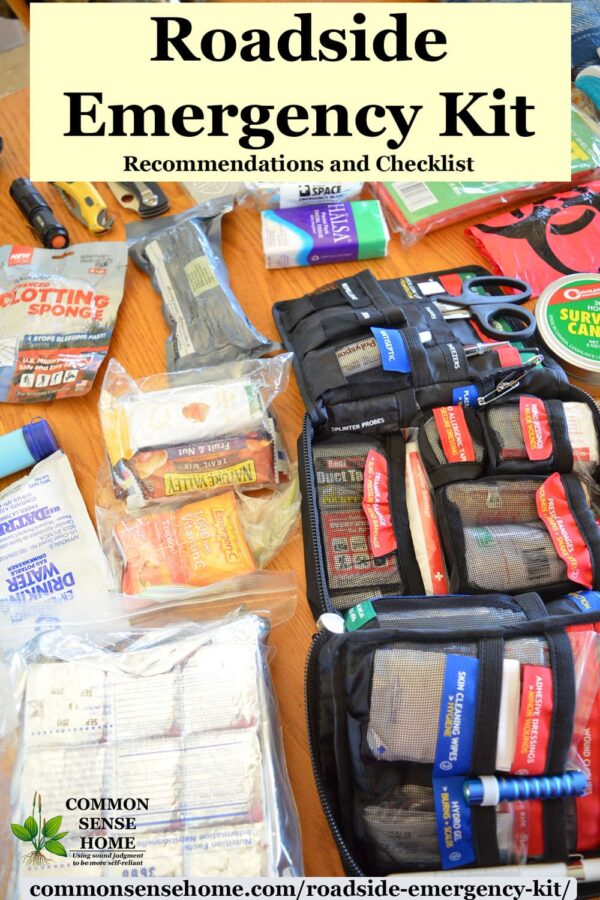
Other Common Sense Preparedness posts you may find useful:
- Car Won’t Start in the Cold? Check Out these Troubleshooting Tips
- 4 Layers of Cold Weather Clothing Everyone Should Know
- Storage and Shelf Life of Over the Counter Medication
- Bug Out Bag (BOB) or “Get Home Bag” DIY Checklist
Last updated Nov 2021


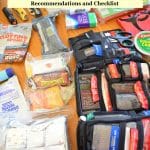

Solid list of supplies. Can’t tell you how many times I get into my GHB at least once every few weeks. It’s great for disasters big and small. Bandaides at the kids games. Lighters and Vaseline cotton balls to light a small campfire. Work gloves to help work on a friends car. A pair of Danner boots to swap with my dress shoes to help push a car out of the snow. These bags aren’t just for SHTF moments folks.
Exactly. You don’t need a zombie apocalypse to appreciate having some extra supplies on hand.